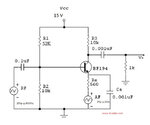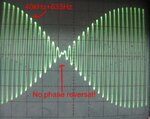voxmagna
Newbie level 6

Hi, I'm very rusty building from schematics. I want an a.m modulator for a 40kHz carrier with a modulating frequency of 1kHz. I've tried 3 or 4 different schematics and all give an output I didn't expect. I expect positive peaks of the envelope to correspond with positive going peaks on the negative half of the envelope with both troughs approaching zero for 100% mod. depth.
I built the simplest single transistor schematic - 40kHz sine carrier feeds the base and a 600 ohm line transformer in the emitter is fed with 1kHz. What I see at the collector on the 'scope is positive going peaks aligning with negative troughs. I've attached a screenshot with the 1kHz modulation superimposed for clarity. I must be a dumbo not understaning what's going on, because I see the same thing with a 2 transistor totem pole, 3 transistor long tailed pair or op-amp designs.
Can somebody explain what I'm missing?
I built the simplest single transistor schematic - 40kHz sine carrier feeds the base and a 600 ohm line transformer in the emitter is fed with 1kHz. What I see at the collector on the 'scope is positive going peaks aligning with negative troughs. I've attached a screenshot with the 1kHz modulation superimposed for clarity. I must be a dumbo not understaning what's going on, because I see the same thing with a 2 transistor totem pole, 3 transistor long tailed pair or op-amp designs.
Can somebody explain what I'm missing?







